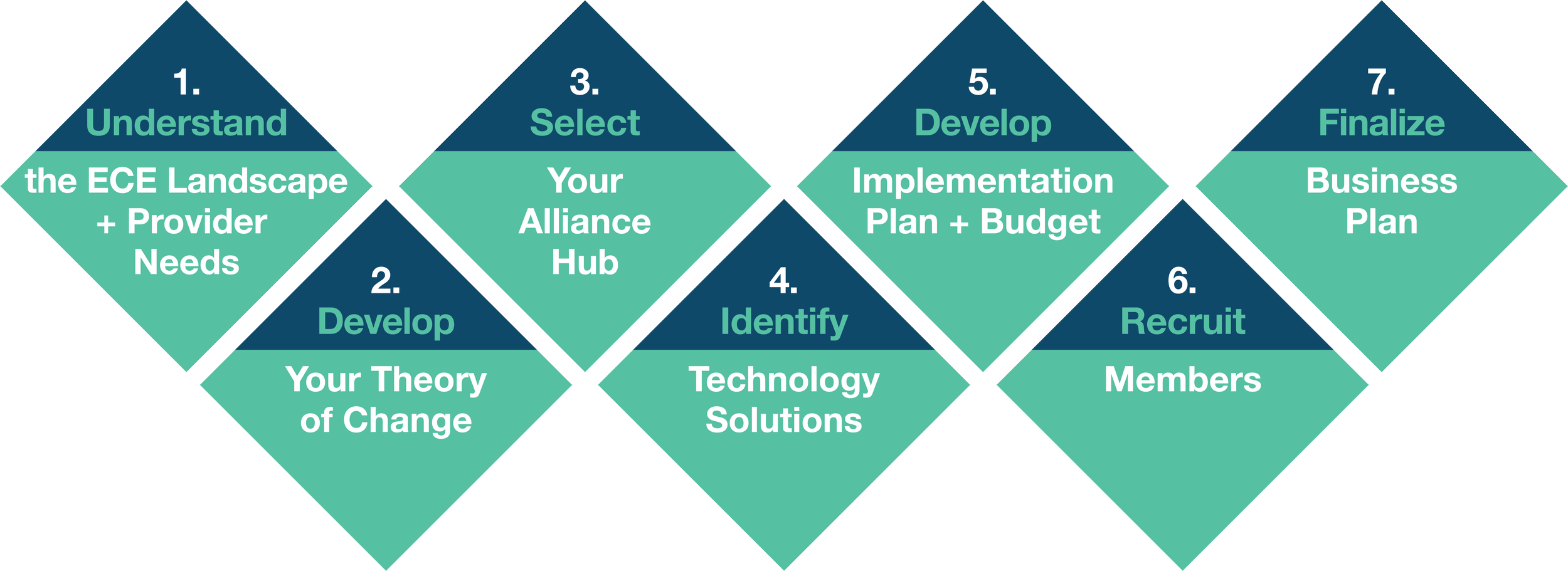
Shared Services Alliance
Implementation Guide
Starting a Shared Service Alliance
OVERVIEW
The process of starting a Shared Services Alliance (SSA) can seem daunting, and those interested in starting or helping to launch one often reach out to ask: “What should we do first?” We’ve created this guide to serve as a roadmap and general guide for potential Alliance stakeholders to help organize your thinking as you begin your design work and implementation planning.
Understanding the
ECE Landscape &
Provider Needs
Understanding what providers might need, want, and value from a Shared Service Alliance is essential to any Alliance's success and sustainability. We recommend that you take the time to use multiple data sources to inform your understanding of the root causes of child care sector challenges as well as how child care business owners view and experience the problems around which you think your Alliance will organize.
Developing Your Theory of Change
A Theory of Change is a project roadmap that helps you clarify what you are trying to accomplish, and the steps needed to get there. The most effective Alliances and Alliances have a laser focus on: Provider outcomes, services needed to achieve those outcomes, and way to collect data to measure progress. Your Theory of Change will serve as the roadmap to launch your SSA.
Theory of Change Overview
Sample Theory of Change from Wisconsin Early Education Shared Services Alliance (PPT Download)
Theory of Change in Shared Services planning template (Word Doc Download)
Service Planning: Choosing Your Service Menu
Watch & learn: SSA strategies to improve wages, benefits, staff retention, and retirement planning
Measurement: Choosing Targets and Outcomes
Suggested Alliance Metrics (PPT Download)
Indicators Planning Sheet (Excel Download)
Selecting Your Alliance Hub
No matter which services providers document as most important for the Hub to deliver, a successful Alliance needs one or more organizations that can provide those services. Organizations thinking of becoming a Hub should do some self-assessment to determine the degree of fit.
IDENTIFY A TECHNOLOGY
SOLUTION
Alliances that seek to improve the financial position of providers will need to offer business leadership that reduces the cost of operations, increases revenue, and allows increased investment in teacher compensation and other quality measures... This can only be achieved through the use of business automation and data sharing tools.
The following resources are available to support your work in this area:
DEVELOPING AN IMPLEMENTATION PLAN + BUDGET
Taking the time to map out your implementation plan and timeline is key to ensuring you’ll be able to deliver services effectively.
In this step you will do the detailed work to: Identify tasks that need to be completed to launch your Alliance (including how you will recruit and onboard members); identify the steps you’ll take to develop service offerings; develop a staffing plan; and develop an Alliance budget.
Sample Budget (Excel Download)
Sample Implementation Plan (Excel Download)
Sustainability Planning Guide (Word Doc Download)
Sustainability Spreadsheet (Excel Download)
RECRUIT MEMBERS
Alliances recruit members in many ways. Sometimes a group of providers initiates the creation of a Shared Services Alliance and in that instance, they self-select into the group and form the initial cohort. More often than not however a third-party entity serves as the catalyst for an Alliance and in that instance founding member providers will need to be selected and recruited. As you plan for member recruitment, keep in mind that success is most likely when all members of the Alliance embrace and are excited about change.
Sample Marketing Materials + Value Propositions (Word Doc Download)
Sample Provider MOU (Word Doc Download)
Create A Business Plan
Once you have answered the questions outlined in this document, you have the elements needed for a business plan. As you put your plan together, use the tools available in this guide as a framework. The plan should include problem you’re trying to solve and your vision for what’s possible; the providers you’re focused on and your value proposition to them; your Theory of Change and service array; your governance structure (who is your Alliance Hub and who is advising); the high-level steps of your implementation plan; your timeline; a three-year budget.
The graphic below illustrates how to approach staffing to keep costs low and maximize efficiencies.

“As we deepen our New Hampshire Shared Service Alliance work and created a roadmap to include a hub, the Start-up Kit provided invaluable guidance for all the key elements of successful planning and implementation.”
—Cellissa Hoyt, State Director, State Early Learning Alliance of New Hampshire



